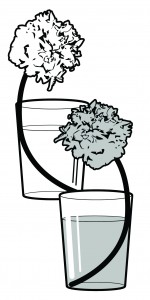Once a week we will be featuring a fun and/or educational activity you can try at home or in the classroom.
Most of you who celebrate Easter have taken part in the time-honored, yet messy, tradition of dyeing Easter eggs. Try a new twist this year, and dye some carnations to brighten someone's day and learn a little in the process about how a plant absorbs water and where it goes.
For this activity, you'll need:

Directions
If you want to go natural (which we at Heifer International strongly encourage), try these websites for tips on how to make dyes with food products:
How does it work?
Most plants "drink" water from the ground through their roots. The water travels up the stem of the plant into the leaves and flowers, where it makes food. When a flower is cut, it no longer has its roots, but the stem of the flower still drinks up the water and provides it to the leaves and flowers.
If the water a plant uses to grow was polluted, would that affect the plant? In what ways?